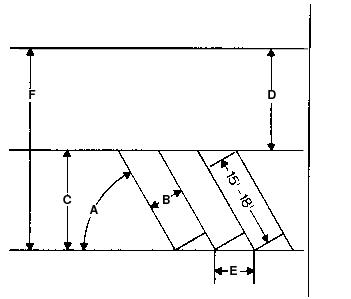20D.130.10 Parking.
20D.130.10-010 Administration.
In the administration of this section, the following rules shall be used where applicable:
(1) Preexisting Parking Spaces.
(a) A development in existence prior to the adoption of the Development Guide or at the time of its annexation to the City, if later, which does not have sufficient parking space on the basis of this section, may continue to operate with the parking deficiency as long as no enlargement or land use change is made which would require additional parking spaces;
(b) When a preexisting use is enlarged so as to require additional parking spaces, the requirements of this section shall apply only to the enlargement;
(c) When additional uses are placed on the same lot with the preexisting use or an enlarged lot of which the preexisting use lot is a part, the requirements of this section shall apply only to the additional use;
(d) When a preexisting use is terminated, the area vacated shall not be occupied by a use requiring more parking spaces than the terminated use, unless the required additional parking spaces are provided.
(2) Separate Parking Facilities. A parking facility which is required for one establishment shall not be considered as part of the parking facility required for any other enterprise, except for cooperative parking as provided in RCDG 20D.130.10-040, General Parking Requirements.
(3) Site Plan Review Required. All proposed parking facilities are subject to the Site Plan Review Process of RCDG 20F.20.20, Site Plan Review.
(4) When a preexisting building, which does not have sufficient parking, is remodeled or rehabilitated but not enlarged, the existing use of the building may continue without providing additional parking. In such event that the land use is changed, the minimum level of parking required consistent with the new land use effected by the change must be met, or an approved TMP must be implemented for the site.
(5) When additional parking is requested in excess of the minimum required parking for a preexisting building, the Technical Committee may require that an approved transportation management program be implemented. Approval of additional parking is not guaranteed and may be granted subject to additional requirements that mitigate the transportation impacts related to the request for additional parking.
(6) Standards for properties in Transition Overlay Areas can be found in Chapter 20D.230 RCDG, Transition Overlay Areas. (Ord. 2390; Ord. 2217. Formerly 20C.20.150(05))
20D.130.10-020 Required Off-Street Parking.
(1) The minimum required and maximum permitted number of parking spaces for each zoning district and land use is noted in the table entitled, “Required Off-Street Parking,” which is incorporated as a part of this subsection. The requirements for land uses that have special parking needs supersede those based on zoning districts for the uses specified, regardless of location. Where calculations of parking requirements result in fractional amounts they shall be rounded up if 0.5 or over.
|
Land Use |
Minimum Parking Required Spaces |
|
Assembly, including auditoriums, theaters and banquet rooms |
10/1,000 sq. ft. of gfa for assembly or 1/5 fixed seats |
|
Bowling |
5/lane |
|
Hotel, motel, excluding restaurant and assembly |
1/rental room |
|
Multi-family housing designed for senior citizens |
.5 to 2/du as found adequate by the Code Administrator |
|
Multi-family housing in business districts |
See requirement for Urban Residence and Multiple Residence districts |
|
Multi-family housing in Downtown |
See requirements for residential uses in Downtown |
|
Multi-family housing in Overlake |
See requirements for residential uses in Overlake |
|
Nursing home or long-term care facility |
1/4 patient beds |
|
Restaurant: Sit-down Take-out |
9/1,000 sq. ft. gfa* 10/1,000 sq. ft. gfa* *Parking requirements for restaurants in the Downtown neighborhood shall be as follows: Old Town district – 2 stalls per 1,000 sq. ft. gfa. The City will review parking standards for Overlake upon completion of Redmond’s study of downtown parking management. The reduced parking provisions below shall not be effective until the adoption and implementation of a Downtown parking management plan. In the Sammamish Trail, Town Square, Anderson Park, River Bend, Bear Creek, Valley View, and Trestle districts – 5 stalls per 1,000 sq. ft. gfa when the restaurant is located in a multi-story building at least 3 stories tall, otherwise the general standards of 9 or 10 stalls per 1,000 sq. ft. shall apply. The Technical Committee may waive the parking requirement for small (less than 750 sq. ft. gfa) restaurant/cafe/deli uses that support/enhance the City’s vision for creating/enhancing Downtown as a pedestrian place provided: 1. The use is located in an office building and primarily serves the occupants and guests of the office building; or 2. The use is visible from, and within 100 feet of, a promenade or Downtown park, such as Luke McRedmond Park, Anderson Park, O’Leary Park, The Edge Skate Park or the 83rd Street Promenade, for example, or within 100 feet of a critical areas buffer of the Sammamish River and access to the River Trail, and the use is designed to enliven the pedestrian environment and primarily cater to pedestrians and outdoor patrons. |
|
Retirement residence |
A minimum of 1 space per unit. If a skilled nursing facility is included, no spaces are required for each bed, but 1.25 spaces are required for each worker on the largest shift |
|
Schools, hospitals, institutions, public facilities and similar uses |
The number of spaces must be adequate to accommodate the peak shift as determined by the Code Administrator after considering the probable number of employees, etc. |
|
Notes: du – Dwelling Unit gfa – Gross Floor Area |
|
|
Zoning District |
Number of Parking Spaces On-Site |
||
|
Minimum Required |
Maximum Allowed |
||
|
Semi-Rural Zone Large Lot Residential Low Density Residential Low Moderate Density Residential |
RA-5 R-1 R-2 – R-3 R-4 – R-5 – R-6 |
2.0/du |
NR |
|
Urban Recreation Agriculture |
UR A |
* |
NR |
|
Moderate Density Residential High Density Residential Residential Development in employment and commercial zones (except Downtown) |
R-8, R-12, R-19 R-20 – R-30 |
1.2/Studio du# 1.5/1 Bedroom du# 1.8/2 Bedroom du# 2.0/3+ Bedroom du# |
NR |
|
Neighborhood Commercial |
NC |
4.0/1,000 sq. ft. gfa |
5.0/1,000 sq. ft. gfa |
|
General Commercial |
GC |
4.0/1,000 sq. ft. gfa |
5.0/1,000 sq. ft. gfa |
|
Business Park Manufacturing Park5 Industry Planned Residential or Commercial Developments |
BP MP I PRD or PCD |
2.0/1,000 sq. ft. gfa 2.0/1,000 sq. ft. gfa 2.0/1,000 sq. ft. gfa 2.0/1,000 sq. ft. gfa |
3.0/1,000 sq. ft. gfa*** 3.0/1,000 sq. ft. gfa*** 3.0/1,000 sq. ft. gfa*** 3.0/1,000 sq. ft. gfa*** |
|
Downtown Districts |
|
|
|
|
Residential Uses (All Downtown Districts)4 |
|
1.0/du |
2.25/unit |
|
Bear Creek, Valley View, and Trestle |
|
3.5/1,000 sq. ft. gfa |
5.5/1,000 sq. ft. gfa |
|
Old Town1, 2, 3 |
|
2.0/1,000 sq. ft. gfa |
2.0/1,000 sq. ft. gfa** |
|
Anderson Park1, 3 |
|
2.0/1,000 sq. ft. gfa |
3.5/1,000 sq. ft. gfa |
|
East Hill1 |
|
2.0/1,000 sq. ft. gfa |
3.5/1,000 sq. ft. gfa |
|
Sammamish Trail1, 2, 3 |
|
2.0/1,000 sq. ft. gfa |
3.5/1,000 sq. ft. gfa |
|
Town Square1, 2, 3 |
|
2.0/1,000 sq. ft. gfa |
3.5/1,000 sq. ft. gfa |
|
River Bend1, 2, 3 |
|
2.0/1,000 sq. ft. gfa |
3.5/1,000 sq. ft. gfa |
|
Town Center3 |
|
3.5/1,000 sq. ft. gfa |
5.0/1,000 sq. ft. gfa |
|
Overlake Districts |
|
|
|
|
Residential Uses (Overlake Village Design District or Overlake Business and Advanced Technology District) |
|
1.0/du6 |
2.25/du |
|
Overlake Village Design District7, 8 |
|
2.0/1,000 sq. ft. gfa |
3.0/1,000 sq. ft. gfa |
|
Overlake Business and Advanced Technology District7, 8 |
|
2.0/1,000 sq. ft. gfa |
3.0/1,000 sq. ft. gfa*** |
Notes:
du – Dwelling Unit gfa – Gross Floor Area NR – No Requirement
* The number of spaces must be adequate to accommodate the peak shift or maximum number of users as determined by the Code Administrator after considering the probable number of employees, users, attendees, etc.
** Bonus available for in-lieu parking fund per RCDG 20D.130.10-040(2).
*** The Technical Committee may consider parking at a ratio as low as 1.5 per 1,000 if a covenant is recorded with the property which limits the uses to warehouse uses and/or limits the number of employees permitted in a building or project.
# Bedroom shall include all rooms that can be used as permanent sleeping quarters.
1 The maximum number of parking stalls allowed shall be increased to (a) 5.0 stalls per 1,000 sq. ft. gfa for the retail components of mixed-use developments and (b) 5.5 per 1,000 sq. ft. for single-story retail development allowed pursuant to footnote 1 of the Permitted Land Uses Chart, RCDG 20C.40.20-030.
2 Developments may provide parking in excess of the maximum allowed parking standards provided the excess parking is also available to the general public for a commercial fee, or no charge, and there is ample signage at the facility to inform users the excess parking stalls are available for public use at no charge or by fee.
3 Parking is not required for storefront ground floor home office space if the space is the lesser of 450 square feet or 25 percent of the gross floor area of the residence the home office it is part of. (The parking exemption provided in this section shall not be effective until the adoption and implementation of a Downtown parking management plan.)
4 Plus one guest space per four units for projects with six units or more. Curbside parking along the site may be counted towards up to 25 percent of the required off-street parking. See curb length for parallel parking under RCDG 20D.130.10-030, Design Requirements for Parking Facilities. (The parking exemption counting curbside parking provided in this section shall not be effective until the adoption and implementation of a Downtown parking management plan.)
5 The maximum number of parking stalls shall be increased to 5.0 stalls per 1,000 square feet of gross floor area (gfa) for membership wholesale/retail warehouse uses in Southeast Redmond.
6 Plus one guest space per four units for projects with six units or more.
7 The maximum number of parking stalls allowed may be increased to 5.0 per 1,000 square feet of gross floor area for the retail components of mixed-use developments.
8 Developments may provide parking in excess of the maximum allowed parking standard, provided the excess parking is also available at all times to the general public, and there is ample signage at the facility to inform users the excess parking stalls are available for public use.
(Ord. 2385; Ord. 2383; Ord. 2352; Ord. 2302; Ord. 2105; Ord. 2027; Ord. 1954; Ord. 1756; Ord. 1734. Formerly 20C.20.150(10))
20D.130.10-030 Design Requirements for Parking Facilities.
(1) Minimum Parking Space and Aisle Dimensions. Refer to table entitled “Minimum Parking Space and Aisle Dimensions.”
(2) Surface of Parking Facilities. Parking facilities for commercial and industrial establishments shall be paved. Other facilities shall have a gravel or other surface at the discretion of the Technical Committee.
(3) Markings for Parking Spaces and Traffic Flow. Parking facilities shall have a permanent means of showing entrances and exits, traffic direction and parking spaces, except where the Code Administrator finds such requirements are inapplicable.
(4) Vehicle Circulation Between Adjoining Property Required. Parking lots shall be designed to provide for off-street vehicle circulation to adjoining property and parking areas where physically feasible, except that driveways and parking aisles may not cross interior pedestrian walkways within 75 feet of a street front in the Downtown; see RCDG 20C.40.105, Downtown Pedestrian System. The Technical Committee may, at its discretion, modify the minimum separation between a vehicular crossing and the street through the Site Plan Review Process. See figure below.
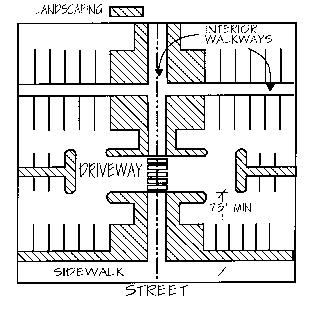
(5) Driveway Location and Design. Guidelines for driveways are found in RCDG Appendix 20D-3, Construction Specification and Design Standards for Streets and Access.
(6) Backing Into Streets Generally Prohibited. Parking facilities shall be designed so exiting vehicles are not required to back into streets, except for residential uses of less than four dwellings per lot on local access streets.
(7) Wheel Stops Required in Parking Facility. Suitable wheel or bumper stops are required to prevent vehicles from overhanging walkways, property lines or other limits of a parking facility and to prevent damage to landscaping.
(8) Off-Street Loading Space. Parking facilities for service vehicles shall be designed to avoid encroaching on other parking areas or public streets while loading vehicles are parked or maneuvering to park.
(9) Walkways Required. Marked walkways, separated from traffic lanes and vehicle overhangs, shall be provided from parking areas to the entrances of establishments.
(10) Pedestrian Access from Parking to Downtown Pedestrian System. Convenient, marked pedestrian access shall be provided from parking areas to interior and street front pedestrian walkways, and the Sammamish River Trail where appropriate, as determined by the Technical Committee.
(11) Landscaping Required. Landscaping requirements for parking facilities are in RCDG 20D.80.10, Landscaping and Natural Screening.
(12) Sight Screening Required. Sight screening requirements for parking facilities are in RCDG 20D.80.10, Landscaping and Natural Screening.
(13) Retail facilities with over 250 parking stalls shall require a minimum of one standard size stall clearly marked in yellow on pavement “EMERGENCY PARKING ONLY.” The location of the parking stall shall be as close as possible to major entries. Large retail facilities may require one stall per entry at the discretion of the Technical Committee.
(14) Design requirements for disabled parking stalls are contained in “An Illustrated Handbook for Barrier Free Design, Washington State Rules and Regulations.” A current edition is kept on file with the Building Official.
(15) Parking Area Location and Design Criteria in the Downtown Neighborhood. Parking areas within the Downtown neighborhood shall meet the following criteria regarding the Downtown Pedestrian System, RCDG 20C.40.105:
(a) General. On Type V pedestrian walkways per the Downtown Pedestrian System Map, RCDG 20C.40.105, parking lots shall not be located between the street and the building. Parking lots and ground floor parking garages shall be separated from streets by building areas (excluding vehicle access points) which are developed as, and made available for, pedestrian-oriented businesses. See figure below.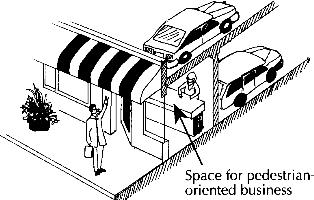
Providing space for pedestrian-oriented business along parking garage frontage facing pedestrian-oriented streets.
(b) Surface Parking Lots on One Type V Pedestrian Walkway. If the subject property abuts a Type V pedestrian walkway, the maximum width of the parking lot parallel to and within 20 feet of the Type V pedestrian walkway may not exceed the lesser of 61 feet or 75 percent of the lot frontage. See Figure 20D.130.10-030(15)(b). Except, public and quasi-public parking lots may occupy 100 percent of the lot frontage, excluding perimeter landscaping.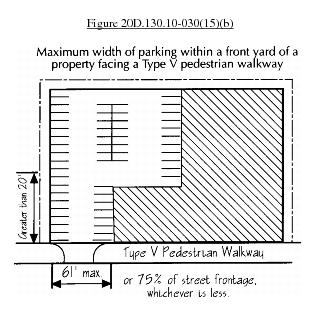
(c) Surface Parking Lots on Two Type V Pedestrian Walkways. If the subject property abuts two or more Type V pedestrian walkways, the following regulations apply:
(i) Parking lots may be within 20 feet of only one of the Type V pedestrian walkways. Variations meeting the intent may be approved by the Design Review Board through site plan review. (See Figure 20D.130.10-030(15)(c).) Except public and quasi-public parking lots may be within 20 feet of two or more pedestrian walkways as determined by the Design Review Board.
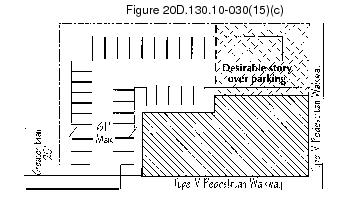
(ii) The maximum width of the parking lot within 20 feet of a Type V pedestrian walkway may not exceed the lesser of 61 feet or 75 percent of the site frontage, if possible. Except, public and quasi-public parking lots may occupy 100 percent of the lot frontage, excluding perimeter landscaping.
(d) Surface Parking Lots on Streets with Other Than Type V Pedestrian Walkways. Surface parking lots on streets with other than Type V pedestrian walkways may occupy no more than 45 percent of the lot width, up to a maximum of 130 feet. Except, public and quasi-public parking lots may occupy 100 percent of the lot frontage, excluding perimeter landscaping.
|
Part of RCDG 20D.130.10-030 Design Requirements for Parking Facilities
|
|||||||
|
MINIMUM PARKING SPACE AND AISLE DIMENSIONS |
|||||||
|
|
|
|
|
|
|
|
|
|
A |
B |
C |
D |
E |
F |
||
|
|
|
|
|
|
|
||
|
Parking |
Stall |
Row |
Aisle |
Curb |
Bay |
||
|
Angle |
Width |
Width |
Width |
Length |
Width |
||
|
|
|
|
|
|
|
||
|
Parallel |
8.00 |
8.00 |
12.00 |
23.00 |
20.00 |
||
|
|
|
|
|
|
|
||
|
|
|
|
|
|
|
||
|
|
8.50 |
16.50 |
11.00 |
17.00 |
27.50 |
||
|
30 |
9.00 |
16.50 |
11.00 |
18.00 |
27.50 |
||
|
|
9.50 |
17.50 |
11.00 |
19.00 |
28.50 |
||
|
|
10.00 |
17.50 |
11.00 |
20.00 |
28.50 |
||
|
|
|
|
|
|
|
||
|
|
|
|
|
|
|
||
|
|
8.50 |
18.50 |
13.50 |
12.00 |
32.00 |
||
|
45 |
9.00 |
19.00 |
13.00 |
12.50 |
32.00 |
||
|
|
9.50 |
19.50 |
13.00 |
13.50 |
32.50 |
||
|
|
10.00 |
19.50 |
13.00 |
14.00 |
32.50 |
||
|
|
|
|
|
|
|
||
|
|
|
|
|
|
|
||
|
|
8.50 |
20.00 |
18.50 |
9.50 |
38.50 |
||
|
60 |
9.00 |
20.50 |
18.00 |
10.50 |
38.50 |
||
|
|
9.50 |
20.50 |
17.50 |
11.00 |
38.00 |
||
|
|
10.00 |
20.50 |
17.00 |
11.50 |
37.50 |
||
|
|
|
|
|
|
|
||
|
|
|
|
|
|
|
|
Notes: (Dimensions are in feet.) When parking lots may have substantial traffic by trucks or other large vehicles, the Code Administrator may establish larger minimum dimensions. At least 50% of the spaces must be a minimum of 18 feet long, 2 feet of which may overhang wheel stops or curb. Up to 50% of the spaces may be 15 feet long, 1 foot of which may overhang wheel stops or curb, and designated for compact cars. Widths may be reduced 1 foot. Aisle turns must be at least 14 feet in width. Requirements for accessible parking spaces are contained in Chapter 15.08 RMC, Building Code. |
|
|
8.50 |
20.00 |
19.50 |
9.00 |
39.50 |
|
|
|
70 |
9.00 |
20.50 |
19.00 |
9.50 |
39.50 |
|
|
|
|
9.50 |
20.50 |
18.50 |
10.00 |
39.00 |
|
|
|
|
10.00 |
21.00 |
18.00 |
10.50 |
39.00 |
|
|
|
|
|
|
|
|
|
|
|
|
|
|
|
|
|
|
|
|
|
|
8.50 |
19.50 |
24.50 |
8.50 |
43.50 |
|
|
|
80 |
9.00 |
19.50 |
24.00 |
9.00 |
43.50 |
|
|
|
|
9.50 |
19.50 |
23.50 |
9.50 |
43.00 |
|
|
|
|
10.00 |
19.50 |
23.00 |
10.00 |
42.50 |
|
|
|
|
|
|
|
|
|
|
|
|
|
|
|
|
|
|
|
|
|
|
8.50 |
18.00 |
25.50 |
8.50 |
43.50 |
|
|
|
90 |
9.00 |
18.00 |
25.00 |
9.00 |
43.00 |
|
|
|
|
9.50 |
18.00 |
24.50 |
9.50 |
42.50 |
|
|
|
|
10.00 |
18.00 |
24.00 |
10.00 |
42.00 |
|
|
|
|
|
|
|
|
|
|
|
(Ord. 2302; Ord. 1954; Ord. 1756. Formerly 20C.20.150(15))
20D.130.10-040 General Parking Requirements.
(1) Cooperative Parking Facilities. Cooperative parking facilities may be provided subject to the approval of the Technical Committee where two or more land uses can be joined or coordinated to achieve efficiency of vehicular and pedestrian circulation, economy of space, and a superior grouping of buildings or uses. When cooperative parking facilities can be provided, the Technical Committee may reduce the on-site parking requirements based on any of the following criteria:
(a) Peak demand occurs at distinctly different times.
(b) The minimum required parking for a multi-tenant facility shall be based upon the minimum amount necessary to satisfy the highest average daily peak demand generated by the uses at a single time period. In no case shall the minimum required parking for a multi-tenant facility be less than 60 percent of the total required for all uses in the facility.
(c) The continuation of the cooperative facility shall be assured by a sufficient legal document, such as a covenant or reciprocal easement agreement, or by participation in a local improvement district or parking cooperative or association.
(d) Shared parking associated with multi-tenant retail and commercial facilities will be considered to be a cooperative parking facility. Lease agreements will satisfy the requirement for a sufficient legal document.
(2) In-Lieu Parking Fees – Fund Created – Comprehensive Parking Plan. An in-lieu parking fee may be submitted to the City for each required parking space which is not provided on-site. The in-lieu parking fee shall be determined annually by the Technical Committee based on current land and construction costs.
There is hereby created a special fund within the Office of the Treasurer-Comptroller into which in-lieu fees shall be deposited to be used only for the construction of public parking facilities. Priorities for construction of parking facilities shall be identified in a comprehensive parking plan and capital improvements program approved by the City Council. The plan shall take into consideration the amount of available on-street parking within an area, the need for concentration of public facilities to prevent proliferation of private parking lots alternating with buildings, the visual and traffic impacts of parking facilities, and the degree to which the parking facilities will encourage pedestrian circulation.
(a) Floor Area Bonus. A floor area bonus shall be granted within the Old Town design area for contribution to the fund. The bonus shall be granted at a ratio of three square feet of bonus floor area for each square foot of structured parking paid for by the in-lieu fee, up to the maximum allowable floor area within the permitted building envelope. The bonus floor area shall be exempt from parking requirements. For example: A 1,000-square-foot building requiring two parking spaces would pay for the construction of two structured parking stalls at 325 square feet per stall. The bonus floor area granted would be three times the two stalls (3 x 650 square feet), or 1,950 square feet of additional floor area.
(3) Alternatives to Parking. The Technical Committee may permit reductions in parking below the minimum if an approved TMP is recorded with the property that effectively reduces parking demand.
The Technical Committee shall require alternative parking programs if there is a need to reduce overall parking to alleviate adverse environmental impacts resulting from excessive ground coverage by impervious surfaces, or severe traffic impacts on adjacent arterial streets.
(4) Parking in Building Setback Areas. In all residential zoning districts and design areas, parking other than in driveways is not permitted in front setback areas. In all other zoning districts, parking is permitted in all setback areas subject to the requirements of the district and the following subsection (5) of this section, Parking Restricted in Shoreline Areas.
(5) Parking Restricted in Shoreline Areas. Parking facilities are prohibited in the waterfront building setbacks established in RCDG 20C.60.25, Site Requirements. (Ord. 2302; Ord. 2217; Ord. 1756. Formerly 20C.20.150 (20))
20D.130.10-050 Parking and Storage of Recreational, Utility and Commercial Vehicles in Residential Neighborhoods.
(1) Purpose. The intent of this section is to define permitted locations for the parking of recreational, utility and commercial vehicles within residential areas of the City such that neighborhood quality and character are maintained.
(2) Exemptions. Pickup or light trucks, 10,000 pounds gross weight or less, with or without a mounted camper unit, which are primarily used by the property owner for transportation purposes are exempt from this section.
(3) Recreational and Utility Vehicles – Requirements.
(a) General Requirements. Vehicles may be parked in any area which is either residentially zoned or used for residential purposes, including Downtown, provided the following conditions are met:
(i) Vehicles shall not intrude into a right-of-way or access easement or obstruct sight visibility from adjacent driveways, rights-of-way or access easements.
(ii) Recreational vehicles shall be operable and maintained in a clean, well-kept state that does not detract from the appearance of the surrounding area.
(iii) Recreational vehicles equipped with liquefied petroleum gas containers shall meet the standards of the Interstate Commerce Commission. Valves or gas containers shall be closed when the vehicle is stored, and, in the event of leakage, immediate corrective action must be taken.
(iv) Vehicles shall not be parked in a waterfront building setback, on slopes greater than 15 percent, in designated open spaces or recreational areas, in sensitive areas, in sensitive area buffers, or in floodways.
(v) Recreational vehicles may be occupied on a temporary basis not to exceed 30 days within one calendar year.
(vi) Unless the International Building Code or International Fire Code dictate otherwise, there shall be no minimum building separation for recreational and utility vehicles.
(vii) Screening Requirements.
(A) Vehicles parked on the side or rear of a residential property must be sight screened from the closest abutting street right-of-way when the vehicle is not parked perpendicular to the right-of-way.
(B) Type I landscaping or an equivalent method as determined by the Code Administrator that meets the intent of this section shall be used.
(C) Other screening may be required at the discretion of the Code Administrator.
(b) Permitted Parking Locations. A vehicle may be located in the following areas listed in order of priority, provided the general requirements of subsection (3)(a) of this section are met:
(i) Within a vented garage or carport;
(ii) In a side or rear yard;
(iii) Within a front yard on a driveway only, parked perpendicular to the right-of-way. See Appendix 20D-3, Construction Specification and Design Standards for Streets and Access;
(iv) In other locations if determined by the Code Administrator to be less obtrusive than the above locations. Screening the recreational vehicle with landscaping, fencing or a combination of the two may be required to meet this standard;
(v) If none of the above locations are feasible, the recreational/utility vehicle must be stored off-site.
(c) Effective Date. Notwithstanding any other provision of this section, for a maximum two-year period from the effective date of the first ordinance codified in this subsection, a recreational or utility vehicle which was owned and was being parked on a property by the occupant of the property on the effective date of this ordinance may continue to be parked, provided that all such vehicles must be in compliance with all relevant requirements in effect prior to the adoption of the revisions.
(4) Truck Tractors and Trailers, Large Commercial Vehicles. Parking of commercial vehicles over 10,000 pounds gross weight is prohibited in residential areas. (Ord. 2149; formerly 20C.20.150(25))
20D.130.10-055 Interim Parking Regulations for the Property Zoned Overlake Business and Advanced Technology Previously Zoned EH-A, EH-B, EH-C, or EH-D.
Repealed by Ord. 2493. (Ord. 2217; Ord. 2027. Formerly 20C.65.55-040)
20D.130.10-060 Parking and Other Vehicle Use Areas with a Transition Overlay.
Repealed by Ord. 2390. (Ord. 2027)



